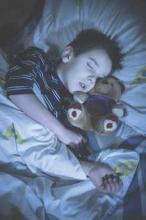To weary parents, the fact that their child does not want to go to bed at night is both puzzling and exasperating. No matter what age, it is important to have a healthy bedtime for the child’s well-being as well as their caregiver’s!
Sleep, like the “canary in the mine,” is vulnerable to disruption by anything from minor illness to changes in schedule, things viewed on media, or emotions in the home, to life changes such as a new sibling, toilet training, or a new school year. In patients on stimulant medicine resisting bedtime, consider the need to finally eat. Asking about these specifically will help you plan an appropriate time to successfully address bedtime conflicts.
Knowing some basic principles about falling asleep can help your counseling. “Sleep drive” builds up over the day like a coiled spring, making falling asleep easier initially than for wakings later in the night. It also means that a nap too close to bedtime reduces the drive. Avoiding any naps (after age 4 years) and naps lasting past 4 p.m. for children under 4, even in car rides, is crucial. Beware of teens “having trouble falling asleep” who have sneaked in a nap after school!
To optimize sleep drive, calculate age-related sleep needs and, ideally, ask parents to keep a sleep diary for 1-2 weeks, especially checking on naps at daycare. Updated sleep duration standards (preschool 10-13 hours; school age 9-11 hours; teens 8-10 hours (see sleepfoundation.org) show that ranges of total sleep are remarkably stable, but may not meet parents’ ideals for time “off duty.”
If placed in bed when not yet tired, anyone will have trouble falling asleep (phase shift). For a child, lying awake in the dark alone is time for active imaginations to conjure fear of separation (> 4-6 months), monsters (for preschoolers), burglars (for anxious school-aged children), or the next day’s social or academic stresses (for school-aged children to teens). Children with anxiety disorders even worry that they may not get enough sleep! A soothing routine with a story in their bed (not media), a spritzing of “monster spray” or a “bedtime ticket” to cash in for “one more thing” (for those who beg) will usually suffice for preschoolers. A “magic flashlight” lends the child some control to check for monsters, but an “exorcism ritual” by the all-powerful parent can be added if needed. Teens are never too old for a chance to talk or even a story read by the parent (but they won’t ask for this).
A secret to managing bedtime struggles is to start the routine at the time the child is now falling asleep to avoid resistance, and keeping wake-up time appropriate to the new schedule. Once falling asleep within 10 minutes, move bedtime 15 minutes earlier each night to reach the schedule, then maintain 7 days per week (or within 1 hour) to prevent resetting the biological clock. Sorry, no movie nights until 2 a.m. or “sleeping in” on weekends! Teens who resist bedtime may be napping, socializing at the “only time” peers are up, addicted to media, or avoiding family. Their cooperation must be engaged to make a change by staying up all night once, then setting a new schedule, or staying up 1 hour later each night until the desired bedtime is reached.
Because sleep includes being paralyzed (REM stages), evolution encourages animals to sleep together to protect from predators. Sleeping alone requires a great deal of reassurance, such as from a friendly atmosphere, favorite stuffed toy, and familiar routine that implies safety. Children could use a toy, pet, or even a sibling to feel safe. While body contact is the most reassuring, children may not return to sleep from the many normal night wakings without it. Most can be weaned from this dependence by the parent sitting by the bed silently, moving one foot closer to the door each night. A promise to “check on you” in 5 minutes also helps.
Other factors making sleep easier include avoiding caffeine, stimulating medicines, or nicotine as well as exciting games, media, or exercise within 2 hours of bedtime. A quiet, dark, cool but not damp location used only for sleeping is helpful, but not always possible. A white noise generator, fan, or radio on static can help.
Many parents strangely expect their child to give up the pleasures of the day and take themselves to bed! As for other kinds of limit setting, parental company is typically needed for brushing teeth, pajamas, and a story. Ideally, it can be fun as a race or with songs, not a yelling match, which undermines the sense of safety. Setting rules about no electronics in the bedroom, even for charging, after a certain hour is often the only solution (even for adults) to the common struggle over ending media.



